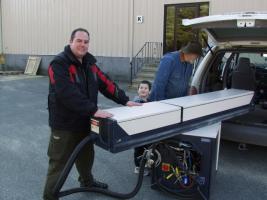The other night I thought I'd blow a bit of "Dust-Off" "air" through the cavity of my old pulsed ruby laser to help cool in down a little before the next pulse. There's a vent tube to blow nitrogen through for that purpose, but I didn't have the nitrogen handy. It's a small air cooled ruby laser with a helical flash lamp.
I pulsed the laser and the "pop" normally heard was a bit louder than normal. Next pulse, no output! What?!? Tried again watching it this time ... lamp fired but no output.
So I opened it up and the normally clear vent tube was black! Opened the cavity for the very first time and everything is covered with a uniform layer of black "soot". WHAT?!?!? No evidence of arching, nothing burned, nothing broken, ruby intact, reflectors on the rod ends were outside the cavity and therefore still clean.
I cleaned the "soot" away with acetone and methanol as well as I could see, reassembled and now it works again but at 2/3 its original output. Here's my questions:
1) Is it well known by everyone working with pulsed lasers that one NEVER uses canned "air" in pulsed laser cavities?
2) Is the "soot" carbon deposited by the UV from the flash lamp reacting with the gas from the can?
3) Is there a better solvent for carbon than methanol (which worked better than the acetone)?
4) Should I have removed the trigger wire from the flash lamp to clean it better?
5) Am I a freakin' idiot for filling the cavity with an unknown gas before pulsing it?
6) Should I re-clean everything to try and get that 1/3 back?
7) If I don't re-clean, will the mechanism that's eating up that 1/3 output eventually break the lamp or ruby?
Thanks for any comments!







 Reply With Quote
Reply With Quote 300EVIL
300EVIL




 ) what about 'MEK'?
) what about 'MEK'?  ....and armed only with his trusty 21 Zorgawatt KTiOPO4...
....and armed only with his trusty 21 Zorgawatt KTiOPO4...



